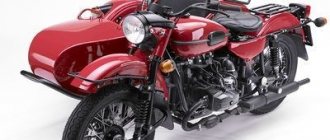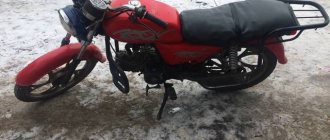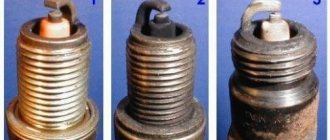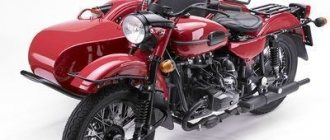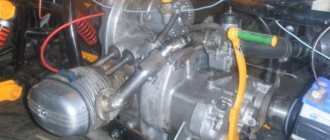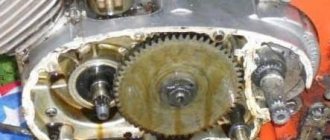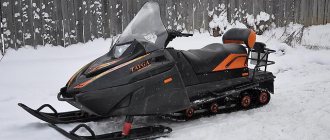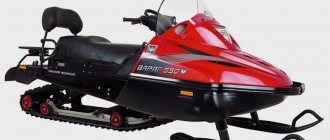home
The fifth generation Jupiter has a significantly modernized engine. The valve timing has been more favorably selected, the cylinder purging has been optimized and the traction and dynamic characteristics have been improved. The power unit of the new IZH Jupiter-5 motorcycle model copes better than its predecessors with increasing resistance speed, which is important when driving with a sidecar on country roads.
The maximum torque has been increased from 3.4 to 3.5 and is achieved at 600-900 rpm less than before. Although the maximum power, compared to Jupiter 4, decreased by 4 hp (from 28 to 24), the power at the most running, medium speeds increased slightly - by 2 hp. The rotation speed corresponding to the maximum power in the “5” model is reduced to 4800-5600 rpm at 5600-6200 rpm for Jupiter-4.
It is pleasantly pleasing that when fully loaded, IZ Jupiter-5 easily picks up speed and feels confident in higher gears, which allows you to switch them much less frequently than in its predecessor. This aspect will appeal to both rural and urban motorcyclists.
Fuel consumption for the single model is 5.9 l/100 km instead of the previous 6.2 and 7.1 instead of 7.5 l/100 km with a sidecar.
Changes in the design of the cylinders and the fins of the heads made it possible to reduce engine noise. In general, the unit has become more reliable due to increased wear resistance of the piston rings, improved crankcase sealing, improved kick-starter mechanism and ratcheting mechanism in the clutch drum.
Engine IZH Jupiter-5-03
The IZ Jupiter-5 liquid-cooled engine differs favorably from counter-air cooling in that it can operate for a long time in extreme mode at high ambient temperatures. This allows use in stationary installations without external airflow. At the same time, the technical, economic and environmental parameters of the motorcycle are increased.
Piston water cooling of the motorcycle IZH Jupiter-5-03 (IZH 6.113-03): 1 – generator cover; 2 – right crankcase cover; 3 – generator; 4 – seal with right cover; 5 – right crankshaft; 6 – right half of the crankcase; 7 – flywheel; 8 – crankshaft seal; 9 – crank chamber cover; 10 – left crankshaft; 11 – left seal; 12 – right half of the crankcase; 13 – crankshaft sprocket; 14 – right crankcase cover; 15 – water pump; 16 – cylinder; 17 – spark plug; 18 – cylinder head; 19 – piston; 20 – connecting rod.
The IZ Jupiter-5-03 liquid cooling system with forced liquid circulation includes: - special cylinders and cylinder heads with cavities for liquid circulation; — cylinder head covers; - manifold with thermostat; — water pump with drive; — a radiator with an expansion tank and steam-air valves in the radiator cap; — a fan with an electric motor and a thermal relay for turning on the fan; — thermostatic switch for overheating warning indicator; — flexible connecting hoses and clamps for their fastening.
The liquid-cooled Jupiter-5-03 engine has pistons, piston rings and a crankshaft that are not interchangeable with the air-cooled engine, along the hole in the upper connecting rod head, into which a special needle bearing is installed.
Antifreeze A40 M (TOSOL) is recommended as a coolant for IZ Jupiter-5-03. It is allowed to use water for a short time, preferably boiled, without allowing it to freeze. Using water in the system leads to premature wear of water pump parts.
Cooling system of the motorcycle IZH Jupiter-5-03 (IZH 6.113-03): 1 – thermal relay; 2 – fan with casing; 3 – collector assembly; 4 – supply hose; 5 – outlet pipe; 6 – carburetor; 7 – upper pipe of the chain cover; 8 – lower pipe of the chain cover; 9 – gearbox drain plug; 10 – flywheel hatch cover; 11 – flywheel hatch gasket; 12 – flywheel cavity plug; 13 – supply hose; 14 – mounting damper; 15 – hose clamp; 16 – radiator protection; 17 – radiator; 18 – plug.
The IZ Jupiter-5-03 cooling system operates in automatic mode, maintaining the liquid temperature within 80...90 degrees. During the warm-up period of a cold engine, the thermostat valves are closed, antifreeze circulates through a small hole in the manifold, having a limiting flow rate and flow rate. When heated to 80 degrees, the thermostat valve opens, reducing resistance to the flow of antifreeze, increasing the speed and thereby increasing the cooling efficiency.
The fan motor turns on at an antifreeze temperature of 92 degrees and turns off at a temperature of 87 degrees.
When the liquid is heated to a temperature of 98...104 degrees, the temperature sensor turns on the overheating indicator on the motorcycle instrument panel.
Safety valves in the radiator plug regulate excess pressure of 0.05 MPa and vacuum of 0.012 MPa.
The increased coefficient of volumetric expansion of antifreeze is compensated by an expansion tank connected by a tube to the radiator.
Coolant is poured into the radiator through the neck until the upper tubes are recessed (filling capacity 2.1 liters). Draining the fluid through the drain holes in the engine with the radiator cap removed.
Motorcycle design
Like many other Izh motorcycles, Jupiter-5 did not receive any special changes in design compared to the fourth Jupiter.
Soon after the release of Planet 5, the designers cheated and borrowed a couple of external elements from it. Namely: the first model released received the usual square-shaped dashboard, which included a turn signal, low-high beam, ignition switch and speedometer. After processing, one panel was divided into two parts: indicators were placed on the first, and a speedometer on the second.
The shape of the tank was also changed. Because of this, the new model received a longer seat, combined with a rear brake light. In conclusion, it should be noted that for its time, and even in the USSR, it was rightfully a branded motorcycle. Only there was no such term then. Everything changes.
Previous entry Motorcycle Izh Planeta-5: Description and technical characteristics
Next entry Motorcycle IZH Planet 5 and the characteristic features of the installed engine.
Engine diagnostics and repair
It is sometimes impossible to find the cause of a breakdown after one visual inspection. In some cases, complete disassembly of the IZH Jupiter 5 engine is necessary. But if you find out the reason, you can quickly solve the problem yourself. Here are examples of main faults and repair recommendations:
- If your kickstarter turns on the crankshaft, you must:
- Tighten the fasteners more tightly, and in case of severe damage, replace the kickstarter shaft and lever. This usually happens after the IZ Jupiter 5 engine has been boosted.
- If the oil is selected incorrectly, especially if it is very viscous in winter, it is necessary to select a more correct temperature regime.
- If the trigger spring is weakened, it must be replaced.
- If no fuel gets into the carburetor, you should clean it in a solvent, and also blow out the channels and fuel supply hose with pressurized air.
- If there is no spark in the combustion chamber, replace the spark plug or clean it.
- When the throttle valve sticks, it is necessary to adjust its drive and clean the carburetor.
- Fuel supply system. The fuel mixture may be oversaturated with air. The solution to this problem is to replace the air filters and install new gaskets.
- Is the capacitor OK? If strong sparking occurs between the contacts, the capacitor must be replaced.
- Severe wear or burning of the spark plug. In most cases, it is the spark plugs that cause poor starting and uneven engine operation.
- The drainage hole of the fuel drum should be cleaned.
- There are cases where the carburetor needle falls out. It needs to be inserted into place and adjusted.
- Cleaning and purging of carburetor channels and jets.
- Adjusting the carburetor to supply gasoline for a combustible mixture. When the quantity is large, popping noises occur in the muffler , because the mixture hits the hot metal walls and burns out there.
- If the fuel manifold drive becomes stuck, the needle must be returned to its standard position.
- In case of low cylinder compression, it is necessary to remove all carbon deposits from the piston and clean the piston rings. And in case of severe damage, completely replace the piston along with the cylinder. To prevent malfunctions, you should use only high-quality fuel and oil from trusted manufacturers.
- Ignition adjustment. With early ignition, you can hear the engine knocking, and with late ignition, popping noises in the exhaust pipe.
These are the main problems that may occur during operation. How to disassemble the IZ Jupiter 5 engine is written in detail in the maintenance book issued upon purchase. Everything stated in it is written in clear text, with diagrams and detailed instructions. Not only the repair of a Soviet unit is within the power of any owner.
There are many questions about how to assemble the IZH Jupiter 5 engine yourself, modifying it. For example, installing a more reliable carburetor or a more stylish and loud muffler can be done quickly enough without significant financial investments.
Tuning an IZH Jupiter engine with your own hands is possible if you have enough time and enthusiasm. You just need to be persistent.
The motorcycle has a favorable ratio of cost, build quality and maintenance requirements. An ideal option for people with a small budget and those who want to get universal equipment. However, frequent breakdowns will take a lot of time. It's worth being prepared for this, since some bikes can be 40-50 years old.
Motorcycle IZH Jupiter 5 real fuel consumption per 100 km: reviews
- Ilya, Republic of Mordovia. I am the owner of the IZH Jupiter 5 motorcycle, which is interpreted as a worthy representative of the middle class car. Quite an impressive device, with 25 hp. a power unit that is simple to use and consumes gasoline to some extent - around 8 liters per hundred kilometers. I owned this vehicle for several years and will not forget it at all. The power unit is petrol, two-stroke type, its acceleration rate is not bad for this class of cars - at least the Jupiter accelerates dynamically on the highway. And it’s already reluctant to take turns. The motorcycle does not like high revs. From my experience, the current model is adequately equipped to carry heavy loads on a stroller as well as on a trailer. Jupiter is a suitable vehicle for rural areas; it has a durable chassis that can withstand all the potholes and potholes that can be encountered on country and rural paths. It is possible to transport two people, and in the trunk it is possible to place several bags of potatoes (for example). The motorcycle copes with such a load perfectly. Unfortunately, malfunctions occur periodically, but at the same time, numerous consumables and parts are budget, but of low quality. I was pleased with the high repairability - almost every part in the motorcycle is in an acceptable place, it is easy to pull out and replace. Some parts can be found in online stores or at auto dismantling yards.
- Evgeniy, Ussuriysk. A thorough, unpretentious and budget-friendly motorcycle to own. I was impressed by the reasonable price; I purchased Jupiter in 2006. I quickly got comfortable behind the wheel and was pleased with the ergonomics of the location of the levers and other controls. The gearbox does its job smoothly. The 26 horsepower power unit is able to operate at both plus 30 and minus 30 degrees. What I'm saying is that the engine is adapted to various temperature changes and starts with half a kick. The maximum speed is around 100 km/h, but 100 km/h is enough for me, which Jupiter reaches easily and naturally. At second speed it is possible to accelerate to 80 km/h. The main thing is to set up the carburetor correctly. I have a semi-automatic transmission, so the clutch acts as a supplement to the gas when starting to move. This solution is interpreted as optimal for quickly gaining speed, without any jumps or delays. In addition, a semi-automatic does not multiply the level of fuel consumption, as opposed to a full-automatic. So, in city mode, Jupiter eats a maximum of 9 liters. This is certainly a lot, but I can imagine what would happen if Jupiter was equipped with an automatic transmission. Bottom line, this is a solid bike that will suit those on a budget. I admit, this is not the most optimal option from the point of view of thoroughness, but with direct hands, Jupiter will last as long as its owner wants. The grandchildren will also ride.
- Vladimir, Tuapse. I ride on a Jupiter made in 1994. I bought this two-wheeler in 2010 for 11 thousand rubles. The vehicle has been in use for eight years, the previous owner looked after it as if it were his own wife. Perhaps I was lucky - I didn’t even have to restore a single bit, since Jupiter was like zero, the distance traveled during the acquisition period was 12 thousand kilometers. The power unit dynamically reaches speed and provides a decent degree of acceleration. I liked the pleasant and energy-intensive chassis, adapted to bad roads and obstacles. The motorcycle is cheap to service and does not require significant expenses. The main costs go to fuel. By the way, in the city limits it is possible to fit 6 liters per hundred kilometers. There is support for budget 76-octane gasoline. I ride on Jupiter with 19 liters. At that time I received a category A license, and by that time I had found a suitable option. For me, there is no motorcycle that is more profitable in terms of budget compliance and reliability. Numerous Jupiter owners complain about a problem associated with malfunctions in the right or left cylinder. Fortunately, this problem can be fixed in a matter of minutes - the Internet can help. Jupiter is very playful, rides smoothly and dynamically, without any left-handed noises or vibrations, as opposed to the Planet.
- Alexander, Murom. Jupiter-5 is an ordinary service, a budget and impressive motorcycle. This is to put it briefly. Perhaps the current model is one of the best Soviet motorcycles equipped with a two-stroke power unit. Even the good old Urals are inferior to Jupiter in terms of thoroughness, dynamism and economy. This is not surprising, since it is designed based on a Soviet motorcycle from the 1940s! My Jupiter is equipped with a side stroller, and it is also possible to connect a trailer and carry gravel, sand, firewood and other household and construction materials. The cylinder block with the crankshaft was borrowed from the KRAZ timber truck. And in general, Jupiter is interpreted as a worthy addition to full-fledged trucks; it is suitable for low-income families, as well as people working for themselves. I'm absolutely one of those people. In the 90s, we earned as much as we could, like everyone else. Fortunately, we still had money in our savings book; we had to drain it quickly, because at that time there was rampant inflation. Thus, funds appeared for this motorcycle. Of course, malfunctions happen repeatedly. However, consumables and parts are cheap, they are always in stock. Fuel consumption is the maximum 11 l/100 that I saw. This is quite a lot for a mid-range motorcycle and, perhaps, this is the only significant drawback of Jupiter. It is allowed to use both 92 and 80 gasoline. Indeed, at 80 the motorcycle accelerates faster. I worked on Jupiter with a side trailer, doing long motorcycle rides, 1-1.3 thousand kilometers long at a time. I drove along dead roads, over potholes and gullies. Fortunately, Jupiter 5 survived most of the tests. Of course, there were some malfunctions that could be corrected in the field. In the 90s, motorcycles of this brand were plagued by malfunctions of the piston crankshafts. Of course, everything is connected with the low quality of spare parts. At that time they did not live, but survived, and did not think much about quality. I have repeatedly changed consumables and parts in Jupiter and repaired it in a timely manner. The last time I did a major renovation was five years ago. The power unit functions smoothly and balanced, and does not suffer from factory defects characteristic of Izh Planet engines and other single-cylinder engines (they are characterized by nervous trembling on the steering wheel and ringing of parts). The power unit on Jupiter growls pleasantly and unobtrusively, and the maximum speed is 120 km/h. Indeed, at such a speed you have to constantly steer, because the motorcycle scours from side to side. I am the owner of the air cooled version. There is no need for liquid cooling; it is only more difficult. The power unit of my Jupiter does not overheat and starts up confidently in cold weather. Model produced in 1992, a wonderful Russian bike for the budget-conscious user. Consumes no more than 8 liters/100 km in urban mode.
- Anatoly, Chuvash Republic. I bought this device for 7 thousand rubles. In use for two years. Currently there are no disadvantages. I immediately appreciated the key advantages of the Jupiter 5 motorcycle - its economy, fast semi-automatic gearbox, soft chassis and high repairability. Sometimes the ignition goes wrong, it needs to be adjusted, but then there will be no problems. I purchased Jupiter disassembled. After a month of painstaking work associated with finding the necessary spare parts and then assembling the motorcycle, setting up the wiring, etc., I made the first start - the motorcycle started up. I was happy, but not for long - after two months the power unit failed. A major overhaul would no longer help him. It overheated greatly even in cold weather. At the service center they advised me to update the power unit and take a motor from Jupiter-3 (I have Jupiter-5). In short, there wasn't much choice. After adjusting the carburetor, the maximum speed was 150 km/h - for comparison, the genuine engine from Jupiter-5 is designed for only 120 km/h. The power unit is an ordinary one in service and does not cause any unnecessary difficulties. The same applies to taxiing - Jupiter steers willingly and confidently turns into sharp turns, no skidding occurs. The power unit itself is heavier than that of the fifth model, but the degree of acceleration is no worse, and even more profitable - after all, the maximum has increased. Fuel consumption is 4-8 liters per hundred kilometers. On light off-road it yields 8 liters
- David, Vladimir region. Jupiter-5 has two key advantages: acceleration and low repair costs. The design is so-so, not for everyone. Another drawback is the mediocre thoroughness. The motorcycle constantly breaks down. However, in the end, this is a pretty good bike. It cost me 40 thousand rubles. The cost of a used model in the current period starts from 2 thousand rubles. I purchased Jupiter-5 in 1996 for 13 thousand. It was a zero motorcycle, with a two-stroke carburetor with 19 liter horsepower, which allowed it to accelerate to 130 km/h. The range is decent, and the fuel consumption level is around 4-6 liters per hundred kilometers. The gas tank size is 21 liters. The two-cylinder engine constantly growls, vibrates and makes noise, vibrations from it transfer to the frame, steering column and seat. However, the acceleration rate is excellent, largely thanks to the dynamic 4-speed gearbox. Drum brakes are more reliable than disc brakes. Of course, this is not my only motorcycle, which I still have in my garage to this day. There are both Voskhod and Ural. I love motorcycles, and occasionally participate in motorcycle races on the highway and cross-country. Jupiter-5 brings sheer pleasure from such long trips. Of course, I always take with me the necessary consumables and parts.
- Vitaly, Tambov. In 2021, I became the owner of an IZH Jupiter-5 motorcycle, which is fun to ride. However, this is still Russian technology, which sometimes breaks down. In addition, it is used, manufactured in 1984. I bought it for 5,000 rubles from the second owner. Of course, before purchasing we checked everything, started the engine, listened to the speed, adjusted the carburetor, etc. In short, during inspection everything worked great. However, after they settled with the owner and brought the Jupiter-5 to my garage, they discovered a malfunction - it turned out that the piston ring was broken, and the piston itself was broken. I had to order a zero piston. I also installed zero rings. However, the right cylinder continued to work exclusively when the speed increased (that is, if you press the gas). At idle, one cylinder practically did not work. However, the motorcycle was quite running and it was possible to ride. One day we went out into the countryside to visit a friend, and suddenly the right cylinder began to “sneeze.” I decided to get there and then see what was going on. I turned the ignition, pulled everything and reconfigured it properly, but the cylinder still continued to sneeze. In fact, I gave up on everything and went to bed - they say, he’s on the move anyway. The next day I rode again and the bike completely died. It refused to start until that time; until now I have not found another motorcycle to “light up”, so to speak. I had two reasons - either the brushes were worn out, or the generator stopped working. Fortunately, local craftsmen in the village helped solve the problem. The motorcycle rides well, but occasionally it suffers from malfunctions that it is not always possible to solve on your own. You need to hire “specialists” or take them with you all the time). Jupiter-5 is a fairly practical model that consumes approximately 4-6 liters per hundred kilometers.
- Anatoly, Kalmykia. I don’t know about others, but my Jupiter doesn’t break at all. I am the owner of a version with a simple two-cylinder engine, a motorcycle manufactured in 1998. I bought it for 4 thousand rubles in 2021. I used it for a year and a half, during which time I managed to study all the positive sides and disadvantages of Jupiter, and I can conclude that the two-wheeler turned out to be worthy. The only thing that bothers me is the poor cross-country ability in muddy ground. Jupiter is absolutely unsuitable for confusion. I purchased the IZH in a damaged state - the previous owner had the motorcycle in the garage for six years and would not start. I also discovered that the garage was leaking in places due to holes in the roof. Fortunately, the two-wheeler was on the move - the power unit started up. I assumed the situation would be bad, but I only had to replace the battery and fill in zero consumables - gasoline and oil. The motorcycle rode confidently and briskly - the maximum speed was 120 km/h. Naturally, I didn’t drive it too hard right away, because first I had to break it in (after all, the bike was after six years of “hibernation”). In short, everything is ok with the chassis, I came to the conclusion to tidy up the appearance of the motorcycle. I dismantled the fuel tank and began sanding, cleaning and painting. Fortunately, I was able to modernize the Jupiter, which began to look like it came from the factory. I repeat once again - on the highway and on dry ground the Izh Jupiter 5 drives great, but in the mud or on any road it sits on its belly and skids helplessly, and even skids. In addition, when off-road, the motorcycle consumes gasoline - it comes out to around 11 l/100, which is simply unacceptable for a motorcycle of the average auto class. Even the Planet is more practical, and at the same time irons out soggy soil much more confidently. The Jupiter's power unit is quite revving, but the cylinders are constantly acting up - first one, then the second. You have to reconfigure from time to time. However, it happens that even adjusting the cylinders does not help, and you have to use other ways to solve the problem - in particular, try installing other spark plugs or lubricating the condenser. The seat is quite comfortable, the handles are not slippery, and your hands do not slip. I ride on Jupiter to this day, but I don’t recommend purchasing it, because for the current period Jupiter-5 is a complete lottery for those who want to feel nostalgic and throw away a lot of money on restoration.
